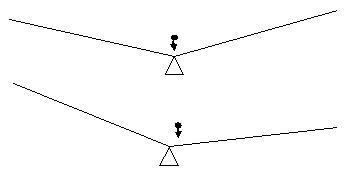So ,u expect a slightly tilted rod to be in that same position [11]
it will rotate and become fully vertical
[1]
a rod of length l,mass m is hinged at origin and is slightly tilted at angle θ as shown
we expect it to rotate in the clock wise direction
but the torque about the orgin due two both halves is same in magnitude =mglcosθ/4
so the cancel each other ??
where is the flaw ??
-
UP 0 DOWN 0 0 9

9 Answers
This rod will not rotate clockwise. It is in state of stable equilibrium.
Generally see saws are made on this funda that their centre of mass is slightly higher. So when they are tilted they rotate to that side. but the one you have drawn will not rotate.
This will not be vertical in pure terms. Net torque will be zero..
But if you look at real world situations they often end up being vertical..
The reason is very strange..... It has to do with the imperfections in making/ suspension of the rod...
so bhaiya , ideally it will same in that same tilted position ?
very hard to digest
Yup ideally it will not rotate..
It will stay the way you keep it
I will give another example of this same situation in a completely different set up
Suppose you have a solid ball of density d and a liquid of density d.
Now you put the ball at a depth x in the liquid. What will happen?
It will stay there itself....
(Even thought there is no torque here!)
actually what happens in practical case(that is actual case) the rod becomes vertical. That is bcoz,the component of the weight of the rod along the rod will change the point of contact of the rod.as a result the Normal force on the rod will act to left of the COM of the rod.and this will provide a torque about the COM in the clockwise direction....that`s what happens in case of a common balance if u knw what i mean....
thanks raja,nishant bhaiya ,@debosmit ,your explanation seems right [1]
@Debosmit, That explanation is ok... but i have a slightly different explanation
Yes g varies with h.. but the friction is large enough to compensate for that... (i mean friction in the joints where the rotation will occur)
The fact is that due to the nature of how a beam balance (the cheaper ones) are made,
the thread at the end of the lower balance sags away, making the effective length higher...
Thus the torque increases....
Oopppsss, I did a small mistake,
The rod drawn in the question is actually in state of neutral equilibrium, instead of stable equilibrium.